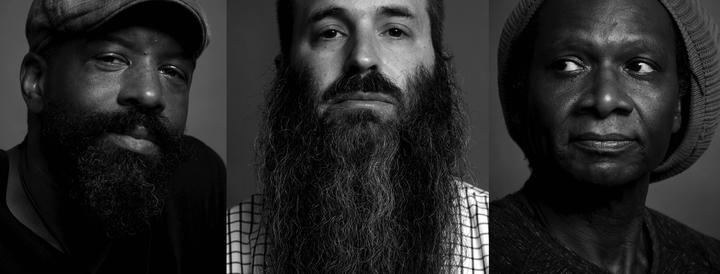New Zion Trio describe their sound as "Forward Roots Reggae meets Spiritual Jazz, Soul, and Doom Dub." It's accurate.
While jazz with its syncopation and expansive harmonics contrasts sharply with dub reggae's fixed, hypnotic, rhythm-heavy grooves, New Zion Trio prove they are not mutually exclusive; these celebrated veterans stretch the parameters of both in their highly original sound. Founded in New York in 2010, the group's original personnel included Jamie Saft on piano and Fender Rhodes, drummer Craig Santiago, and acoustic bassist Larry Grenadier. All extremely busy individuals, they honed their sound in New York clubs whenever they could get together. Their recorded debut, Fight Against Babylon, was issued by Veal Records in 2011 to consistently positive reviews. One track, "Hear I Jah," was included on Grooveman Spot's compilation Mellow Groove Vibes in 2013.
Grenadier left in 2012 and was replaced by bassist Brad Jones, a bandleader in his own right, but who has worked with everyone from Ornette Coleman to Jazz Passengers to Don Byron. This group released Chaliwa in 2013. International critical acclaim greeted the release and one track, "Ina Sade Dub," was remixed by producer Christian Castagno for Don Letts Presents: Dread Meets Yasushi Ide - In the Land of the Rising Dub. It was followed by intermittent live dates -- whenever they could find time away from their hectic individual schedules -- over the next couple of years. Beginning in 2014, Saft started an ongoing relationship with RareNoise Records that resulted in Sunshine Seas, a third New Zion Trio album. A co-led date with Brazilian percussionist Cyro Baptista, it was released in the spring of 2016. (Thom Jurek, Rovi)
….Of the American bands at this year's festival, one that stood out for special mention was the New Zion Trio with keyboardist Jamie Saft. Joining Saft was longtime NZ bassist Brad Jones and drummer Hamid Drake. Performing in Pakkahuone to a full house in a mid-afternoon show on Sunday, the accent was on the upbeat, both temperamentally as well as rhythmically.
With Jones flanked on either side by Saft and Drake in what felt like a friendly face-off between drummer and keyboardist, the result was a kind of sanctified party music as one tune inevitably rolled into another, everything marinated in some form of dub, reggae or an admixture of the two. Serving as a kind of motif, Saft began the concert on the piano, playing beautiful almost classical lines that subtly allowed for an eventual dub vibe. What followed had as much to do with rock as the music became more animated with his pivot to the electric keys. This was Saft's "Twelve Tribes," a medium-tempo piece that let Jones' bass come forward for a spell as the lead instrument. This pattern repeated itself: a fully acoustic approach on the Steinway eventually giving way to a light touch on either Saft's Korg CX-3 or his Rhodes Stage Piano. As the band moved through "Twelve Tribes" and into
"The Red Dies," Saft's funky electric chords tastefully laced with some blue chords led to Drake's first solo, a powerful yet restrained groove that enhanced the upward pulse. And while Drake (new to the band on drums) and Jones were essential partners in fomenting the unique blend of dub and reggae that is New Zion, it was clear that this was Saft's program and show. The playful bounce of "Chalice Pipe" maintained the set's buoyant spirit, Saft's playing continually mixing piano virtuosics up and down the keys with a slew of chords and arpeggios, the sound of an churchly, funky organ suddenly front and center. Another two-chord vamp, "Chalice Pipe" suggested that kind of sanctified party music where anyone could get up and dance (no one did, at least not from where I was sitting). It was very rhythmic, greasy even, Drake's command of the skins and cymbals deep in the pocket. (By JOHN EPHLAND -AAJ)
https://jamiesaft.com/video/new-zion-trio/
https://newziontrio.bandcamp.com/
https://www.facebook.com/newziontrio/

